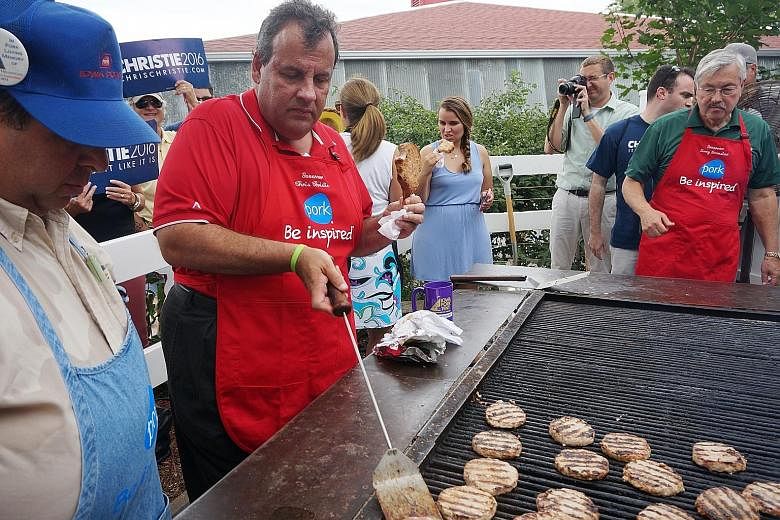Presidential candidates criss-cross the United States to spread their campaign message and reach out to voters - and the one state they never ignore is Iowa.
In fact, 11 of the 23 candidates tracked by the National Journal magazine visited Iowa more than any other state.
Louisiana Governor Bobby Jindal and former Governor of Arkansas Mike Huckabee both visited the state 15 times in the last nine months. In that same time, former secretary of state Hillary Clinton visited just seven times, but made it one of her first stops after announcing her bid for the presidency in April, hoping to regain some support after the huge blow in 2008, when Iowa's Democratic caucus-goers picked rival presidential hopefuls Barack Obama and John Edwards over her.
Iowa's political significance hinges on the fact that it holds the first caucus in the nation - scheduled for Feb 1 next year - which kicks off the process through which party nominees are selected for the presidential election. While winning Iowa does not mean a free pass to the White House, the caucus winnows the field of presidential candidates, and staying at the top of the pack is an early indication of the support for a presidential hopeful.
At the moment, Mr Donald Trump is leading in Iowa with 19.3 per cent of Republican votes, according to political website

-
IOWA: FAST FACTS
-
Population (2014) 3.1 million
-
Population breakdown by race (2013)
• White alone: 92.5 per cent
• Black or African American alone: 3.3 per cent
• Asian alone: 2 per cent
• Hispanic or Latino*: 5.5 per cent
-
Per-capita annual income (2009-2013)
US$27,027 (S$37,900)
(National: US$28,155) -
People living below poverty level 2009- 2013
12.4 per cent
(National: 15.4 per cent) -
Land area 144,699 sq km
-
Source: US Census Bureau
*Hispanics may be of any race, so are also included in applicable race categories.
Real Clear Politics; Among Democrats, Ms Clinton is polling at 50.5 per cent.
With less than six months to the caucus, presidential hopefuls have been stepping up their activities in what is known as the Hawkeye state, after American Indian Chief Black Hawk.
Until this year, the state hosted the Iowa Straw Poll - a milestone on the path to the White House for Republican candidates. But the event was cancelled after major candidates decided against spending campaign dollars on the poll. So other events like the Iowa State Fair - which ended on Sunday - have become even more significant and provide the perfect convivial setting for candidates - more than a dozen turned up this year - to meet voters.
Candidates were seen taking selfies, talking to children, giving speeches on the "soapbox" and biting into greasy fair food, like pork chop on a stick, to show they are just "one of the guys".
Billionaire Donald Trump adopted a different strategy to reach out to the average fair attendee this year - he arrived in his helicopter and offered rides to children.
Mr Michael Priest, 53, who lives in Chariton, a 50-minute drive from Iowa's capital, Des Moines, said he tries to catch the candidates at the fair because "it is easier to judge the truthfulness and character if I see them in person".
Politicians also take some risks by participating in the "soapbox" event where they have 20 minutes to address the public. Hecklers are often part of the deal. New Jersey Governor Chris Christie, for example, was interrupted by protesters calling for a pathway to citizenship, while animal rights activists hijacked his stage and had to be hauled off by police officers.
On caucus night, Iowans gather in close to 4,000 precincts, be it a church, school gym, or someone's living room to listen to speeches and cast their vote.
"There are impassioned speakers who are sometimes your neighbours telling you why you should vote for a candidate. It's almost Pentecostal," said Mr Tom Leners, 56, executive director of the Madison County Development Group, who lives in the town of Winterset.
The state's two main industries are manufacturing and agriculture. Iowa is the largest producer of corn, soya beans, eggs and pork in the US so the agriculture lobby is very strong. With a population of just 3.1 million, it has six times as many pigs as people.
"It's more rural here than the rest of the country, people live in small towns so - while this is a bit of a stereotype - there is a different mindset; people focus on self-reliance, they are more traditional and big government is an issue," said Professor Mack Shelley, the political science department chair at Iowa State University.
While some tend to write off the state as being racially homogeneous - 92 per cent of residents are White - and thus unrepresentative of America, experts point out that Iowa is very diverse in political ideology. It is considered a purple or swing state where Independents make up about 40 per cent of the voters, while Republicans and Democrats account for 30 per cent each.
"It is seen as a bellwether for the nation as a whole," said Prof Shelley.
Even though Iowa accounts for just six of the 270 electoral college votes needed to win a presidency, political science professor Steffen Schmidt, also from Iowa State University, said this is a period of American history and politics where "battles are won by small margins", so every vote counts.

